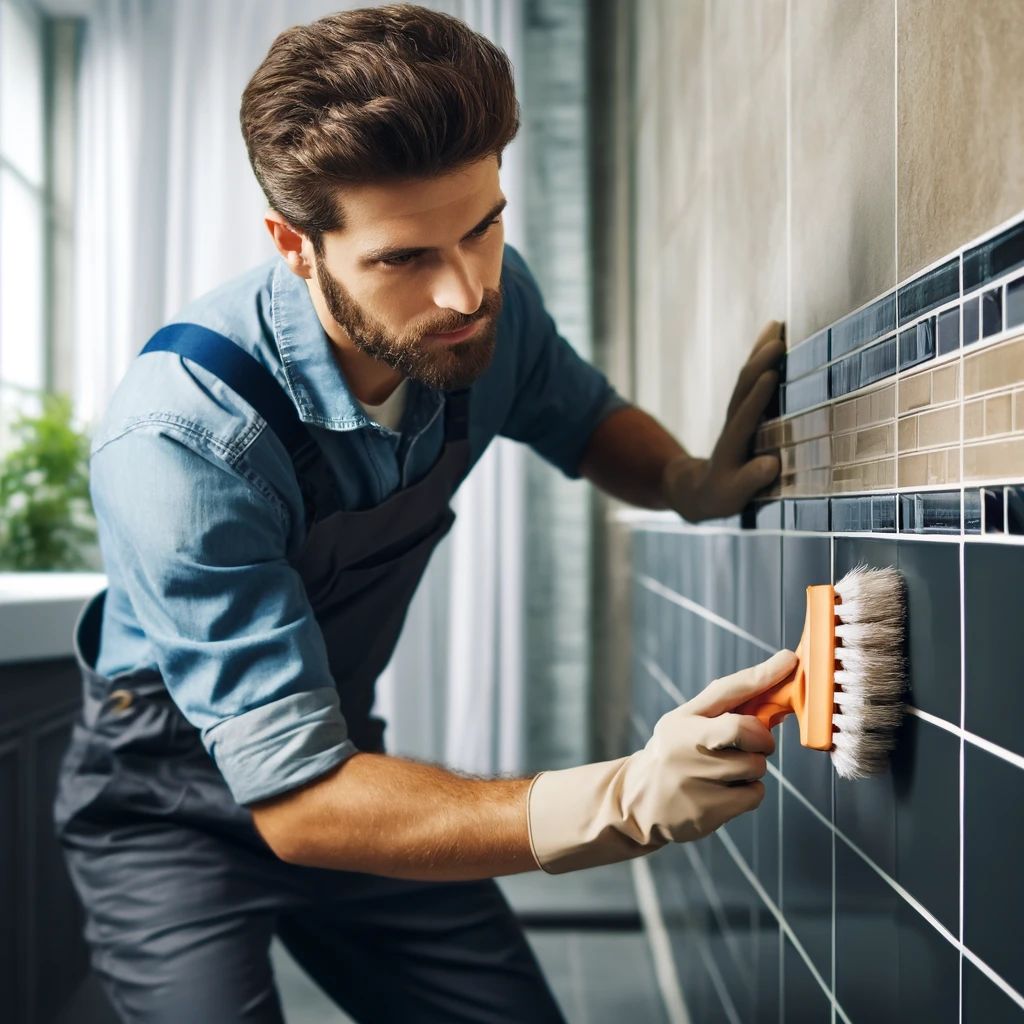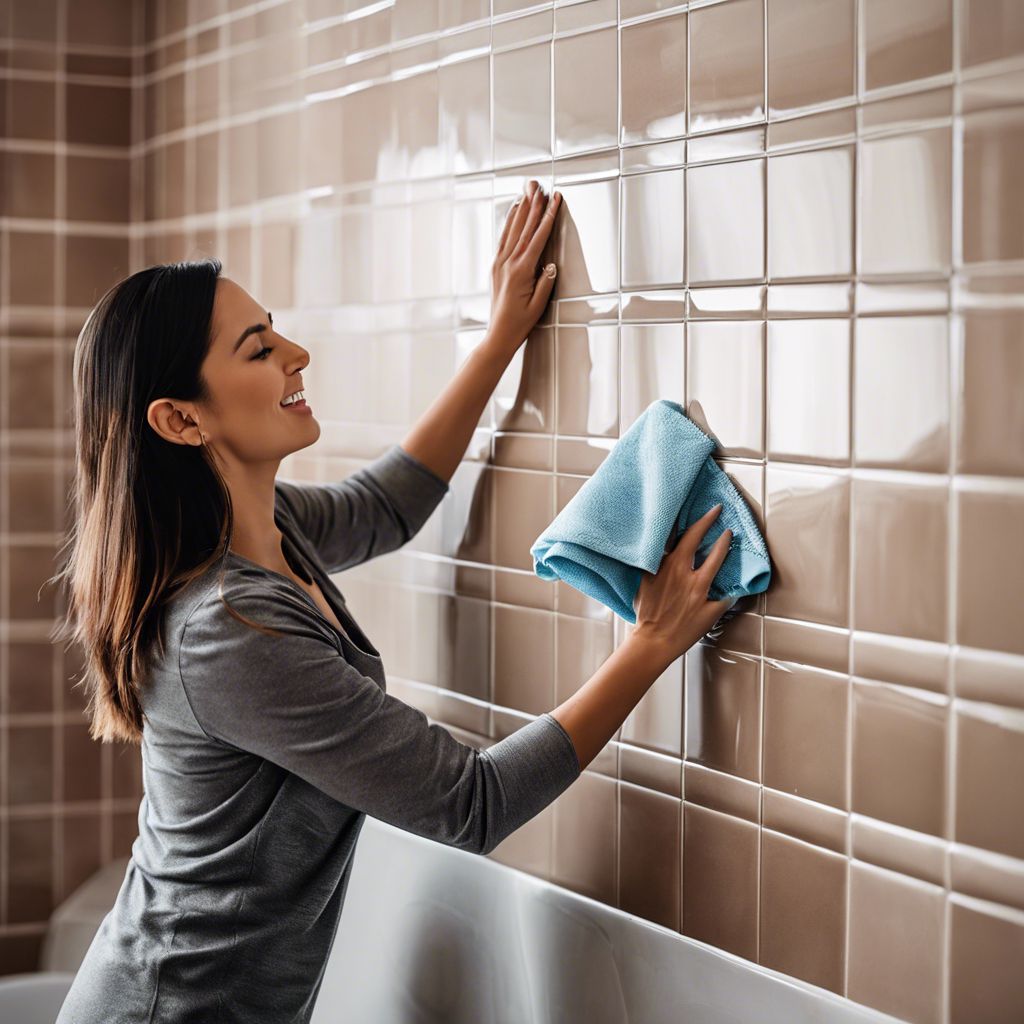
Key Takeaways
- A well-executed DIY ceramic tile wall refinishing project can significantly improve the look of your space without the need for expensive replacements.
- Essential tools for the job include protective gear, a tile cleaner, sandpaper, primer, paint, and sealer.
- Proper cleaning, repairing, and sanding of tiles are critical steps for ensuring paint adhesion and durability.
- Choosing the right type of primer and paint is key to achieving a professional finish.
- Maintenance of refinished tiles involves gentle cleaning and periodic touch-ups to address any wear and tear.
Transform Your Space with DIY Ceramic Tile Refinishing
First things first, let’s talk about why you’d want to refinish your ceramic tile walls. Maybe the color is outdated, or perhaps the tiles are still in good shape but need a refresh to match your evolving style. Refinishing is a smart choice because it’s far less expensive and less messy than tearing out and replacing the tiles. Plus, it’s incredibly rewarding to see the transformation unfold right before your eyes.
Refreshing your home’s ceramic tile walls can be a game-changer for the entire look and feel of your space. Whether it’s a dated bathroom or a kitchen backsplash that’s seen better days, giving your tiles a new lease on life is not only satisfying but also cost-effective. It’s a project that can be tackled over a weekend.
The Impact of a Refreshed Tile Wall
Imagine walking into your bathroom and seeing a bright, clean tile wall where once there was a dull, lifeless surface. That’s the magic of refinishing! Not only does it elevate the aesthetics of your room, but it also adds value to your home. You can customize the finish to your liking, opting for a high-gloss shine or a matte look, depending on the ambiance you’re aiming for.
Gathering Tools and Materials Needed
Before diving into the nitty-gritty, let’s gather all the necessary items. This isn’t the time to cut corners—opt for high-quality products that will give you a lasting finish. Visit your local home improvement store or order online, but make sure you have everything on hand before starting. There’s nothing worse than having to pause mid-project for a supply run!
What You Need to Get Started
Like any successful project, having the right tools and materials from the get-go is important.
- Protective gear: safety glasses, gloves, and a ventilation mask
- A quality tile cleaner to remove grime and soap scum
- Fine-grit sandpaper or a sanding block to create a surface the primer can adhere to
- A reliable primer designed for ceramic surfaces
- Tile paint in the color and finish of your choice
- A clear sealer to protect your handiwork
- Paintbrushes, rollers, or a sprayer, depending on your application preference

Ceramic Tile Wall Refinishing Steps
Now that we have our tools and materials, let’s break down the steps. We’ll be cleaning, repairing, sanding, priming, painting, and sealing the tiles. Each step is critical and sets the stage for the next.
Step 1: Cleaning the Canvas
Start by giving your tiles a thorough cleaning. This isn’t just a cursory wipe-down; you need to remove all the dirt, oils, and any mildew that could prevent the primer from sticking. Use a high-quality tile cleaner and a scrub brush to get into the grout lines. Rinse well and allow the tiles to dry completely. Patience is key—moisture is the enemy of adhesion.
Once the tiles are dry, give them a once-over. If they’re still not squeaky clean, repeat the process. Clean tiles will make all the difference in your refinishing job.
Step 2: Repairing Any Damage
Look closely at your tiles. Are there any cracks or chips? Now’s the time to make repairs. Repair any damage using appropriate materials such as tile adhesive or epoxy filler. You can find tile repair kits at most home improvement stores. Follow the instructions carefully to ensure a smooth surface. Any imperfections will only be magnified once painted, so take the time to get it right.
After repairs, wait for the recommended curing time before moving on to sanding. This ensures that the filler material is fully set and ready to be sanded down to match the surrounding tile.
Step 3: Sanding for Superior Adhesion
Sanding might seem tedious, but it’s a step you can’t afford to skip. Using fine-grit sandpaper or a sanding block, gently scuff the tile surface. This creates a texture for the primer to grip onto. Sand evenly, and wipe away the dust afterward. This preparation will pay off in the durability of your refinishing job.
Once you’ve finished sanding, wipe the tiles down with a damp cloth to remove any remaining dust, and then let them dry completely. We’re aiming for a clean, slightly textured surface that’s ready to accept the primer.
Step 4: Applying the Magic: Primer
With your tiles cleaned, repaired, and sanded, it’s time to apply primer. This is the foundation of your refinishing job. The right primer will ensure your paint adheres properly and remains durable over time. Apply a thin, even coat according to the manufacturer’s instructions and allow it to dry completely before moving on to painting. This might take a few hours, but it’s worth the wait for a solid base.
Taping and Protecting Adjacent Areas
Before you begin applying any primer or paint, it’s important to protect the surrounding areas. Use painter’s tape to carefully mask off the edges of the tile, ensuring a clean, sharp line between the tile and the wall, ceiling, or floor. Cover any surfaces you want to protect with drop cloths or plastic sheeting. This includes sinks, bathtubs, countertops, and any fixtures that you can’t remove. It’s better to spend a bit more time on this step than to have to clean up paint splatters later.
Remember to keep the room well-ventilated. Open windows and use fans to circulate air and disperse any fumes from the products you’ll be using.
Choosing the Right Primer
Not all primers are created equal, especially when it comes to refinishing ceramic tiles. Choose an epoxy or bonding primer that’s specifically formulated for ceramic tiles. These types of primers are designed to adhere to slick surfaces and will create the strong foundation needed for your topcoat of paint.
Brush, Roll, or Spray? Applying Your Base
How you apply the primer is up to you, but each method has its benefits. Brushing can be more precise, rolling can cover a larger area quickly, and spraying can provide a very smooth finish. If you choose to spray, make sure to protect yourself with a mask and keep the room ventilated. No matter which method you choose, the goal is to achieve a smooth, even base without drips or heavy spots.
Step 5: Painting or Applying the Refinishing Product
Once the primer is dry, it’s finally time to bring your vision to life with paint or a refinishing product of your choice. There are several options available, including tile paint, epoxy coatings, and specialized tile refinishing kits. Make sure to choose a product that is suitable for ceramic tiles and follow the manufacturer’s instructions for application.
Color and Finish: Picking Your Paint
Choosing the color and finish of your paint is where you get to have some fun and let your creativity shine. Go for a color that complements the room or be bold and make a statement. Just make sure the paint is suitable for ceramic tiles and is resistant to mold and mildew. Here are some finishes you can choose from:
- Glossy finish for a shiny, reflective look
- Semi-gloss for a bit of shine without the glare
- Satin finish for a smooth look with a low sheen
- Matte finish for no shine and a contemporary feel
Once you’ve picked your color and finish, it’s time to get painting. Apply the paint in thin, even coats to avoid drips and streaks. Let each coat dry thoroughly before applying the next. This patience will pay off with a professional-looking finish.
As you paint, use a brush to cut in around the edges and a roller or sprayer for the larger, flat areas. If you’re using a sprayer, keep the nozzle at a consistent distance from the tiles and move in steady, even strokes. Work systematically from one side of the room to the other to ensure even coverage.
Depending on the color and type of paint, you may need a second or even third coat to achieve the depth and uniformity you’re after. Remember, thin coats are the secret to avoiding drips and getting that smooth, professional look.
Setting It Right: Drying and Curing Times
After painting, the drying and curing time is important. While the paint may feel dry to the touch within a few hours, it can take several days or even weeks to fully cure. Check the manufacturer’s instructions for specific times. During the curing process, avoid using the room as much as possible and keep it well-ventilated to speed up the process.
Step 6: Seal the Deal: The Finishing Touch
The final step in your ceramic tile refinishing project is to seal your work. A clear sealer will protect your paint job from moisture, scratches, and wear, especially in high-traffic areas or spaces like bathrooms and kitchens. Apply the sealer as directed, usually with a brush or roller, ensuring even coverage. Let it dry completely before using the space.
Why Sealing is Critical
Sealing your tiles isn’t just an optional step—it’s essential for longevity. The sealer acts as a barrier against water, stains, and everyday use. It also makes cleaning easier and helps maintain the vibrancy of the paint color. Without a sealer, your beautiful new tiles could quickly become worn and dingy.
Application Tips for a Smooth Finish
For a smooth, bubble-free finish, apply the sealer with a high-quality brush or roller. Start in the corner and work your way across the tile, maintaining a wet edge to prevent lines. If using a roller, use light pressure to avoid air bubbles. After applying, check for any drips or uneven areas and smooth them out promptly.

Maintaining Your Masterpiece
Now that your tiles look brand new, you’ll want to keep them that way. Regular cleaning with a gentle, non-abrasive cleaner will help maintain the finish. Avoid harsh chemicals and scouring pads, which can scratch and dull the surface. Wipe up spills promptly to prevent staining, and for best results, reapply sealer every few years to keep your tiles protected and looking great.
Cleanliness Is Key: Easy Cleaning Tips
To keep your newly refinished tiles sparkling, here’s what you need to do:
- Use a soft cloth or sponge for daily cleaning.
- Opt for pH-neutral cleaners that are safe for sealed surfaces.
- Rinse with clean water to remove any cleaner residue.
- Dry with a soft towel to prevent water spots.
With these steps, your refinished ceramic tile walls will be a source of pride for years to come. Enjoy the fruits of your labor and the fresh, updated look of your space!
When to Touch Up: Addressing Wear and Tear
Even the best DIY jobs will eventually show signs of wear and tear, especially in areas with high traffic or frequent use. When you notice the paint on your ceramic tiles starting to chip or peel, it’s time for a touch-up. This doesn’t mean redoing the entire wall—usually, a quick spot treatment will suffice. Clean the affected area, lightly sand it, and reapply primer, paint, and sealer as you did before. This will keep your tiles looking fresh and extend the life of your refinishing job.
Remember, the key to a successful touch-up is blending the new paint with the old. Feather out the edges of the new paint to make the repair as invisible as possible. And if you’ve saved some of the original paint, use it for the touch-up to ensure a perfect color match.
Enjoying Your Revitalized Ceramic Walls
Once you’ve completed the refinishing process and allowed ample time for drying and curing, it’s time to step back and admire your handiwork. Your ceramic walls should look as good as new, if not better. The satisfaction of completing a DIY project like this is immense, and the impact on your space is just as significant. You’ve given your room a fresh, updated look without the expense and hassle of a full renovation. Enjoy your revitalized ceramic walls and the feeling of accomplishment that comes with tackling such a project on your own.

Frequently Asked Questions (FAQ)
Can I refinish ceramic tiles in high-moisture areas like showers?
Yes, you can refinish ceramic tiles in high-moisture areas like showers, but you must ensure that the refinishing products you use are suitable for wet environments. Look for primers, paints, and sealers that are specifically designed to withstand moisture. It’s important to allow each layer to dry and cure completely before exposing it to water to ensure the longevity of your refinishing job.
How long will my DIY tile refinishing last?
With proper preparation, application, and maintenance, your DIY tile refinishing can last for many years. On average, a well-done refinishing job can last anywhere from 5 to 10 years, depending on the level of wear and tear it’s exposed to. Regular cleaning and occasional touch-ups will help extend the life of your refinishing work.
Are there any special considerations for choosing paint for ceramic tiles?
When selecting paint for ceramic tiles, there are a few special considerations to keep in mind:
- The paint should be labeled for use on ceramic or tile surfaces.
- Opt for products that are mold and mildew resistant, especially if refinishing tiles in a bathroom or kitchen.
- Choose a finish that suits the function and style of the room—glossy finishes are more durable and easier to clean, while matte finishes may be more suited for walls with less traffic.
By choosing the right paint, you’ll ensure a finish that not only looks great but also stands up to the demands of your space.
Is it necessary to use a professional or can I do it myself?
While hiring a professional can ensure a high-quality finish, many homeowners successfully complete ceramic tile refinishing as a DIY project. If you’re comfortable with painting and willing to invest the time in proper preparation and application, DIY refinishing is a viable and rewarding option. Just make sure to follow all the steps carefully and give yourself plenty of time to complete the project without rushing.





Leave a Reply